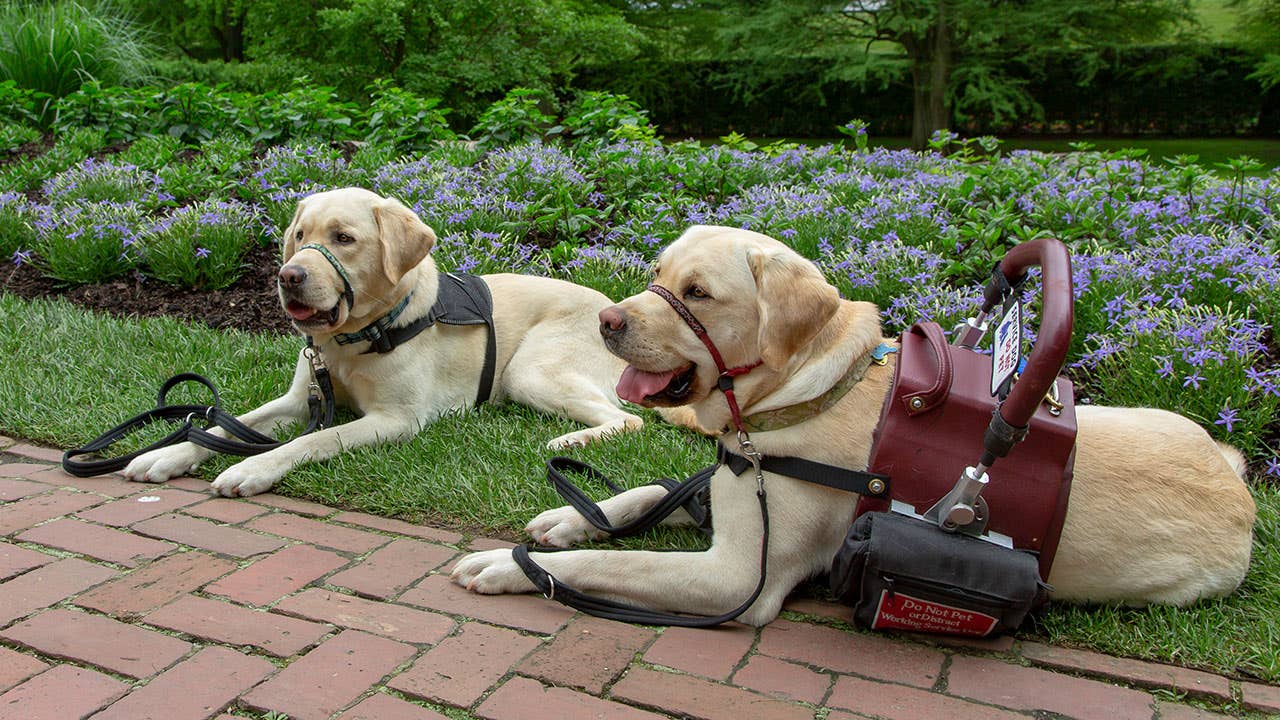Life-changing companions: How to afford a service dog

The Bankrate promise
At Bankrate we strive to help you make smarter financial decisions. While we adhere to strict , this post may contain references to products from our partners. Here's an explanation for .
Service dogs are specifically trained to help individuals living with physical, psychiatric, intellectual or sensory disabilities.
Service dogs can help with physical needs like guiding people who are blind, alerting people who are deaf, pulling a wheelchair and alerting and protecting a person who is having a seizure. Dogs can also help with mental illness by reminding someone to take medications or calming a person with PTSD during an anxiety attack. Many individuals depend on service dogs to help them live their everyday lives.
That said, getting a service dog can be an expensive endeavor. This is especially true if you aren’t willing to do the training yourself. Before getting a service dog, make sure to check your local laws about eligibility requirements and plan how you will be able to afford one.
Service dog statistics
- About 1 in 4 adults (27%) have some type of disability in the U.S.
- There are approximately 500,000 service dogs in the U.S. alone.
- The average cost of getting a trained service dog in the U.S. is between $10,000 and $30,000, with high-skilled service dogs costing as much as $50,000.
- Service dog trainers charge an average of $150 to $250 per hour of training, however, the total cost of training the dog will depend on the specific skill set they’ll be learning.
- It takes between six months to a year (over 120 hours) to properly train a service dog.
- The average wait time to get a service dog varies depending on the agency, but you can expect to wait at least between 1 and 2 years for your companion.
- In addition to initial costs, you can expect to spend at least $1,200 a year between food, veterinary costs and ongoing training for your dog.
Types of service dogs
Service dogs are not one-size-fits-all. Each dog is trained to help individuals with different needs. Here’s a quick breakdown of the most common types of service dogs and their specific skill set.
-
Guide dogs are specifically trained to help the blind and visually impaired. Instead of wearing vests, like most service dogs, they tend to wear a special harness with a handle that makes it easier for people with vision-related disabilities to hold on to them. Some of the most common types of breeds that serve as guide dogs include labradors, German shepherds, golden retrievers and labradoodles.
-
Just as their name suggests, hearing dogs are trained to help the deaf and other individuals with hearing disabilities. These service dogs are trained to alert their owners when they hear an important sound, such as an alarm, doorbell ring, sirens and more. Labrador retrievers, German shepherds, Boston terriers, poodles and cocker spaniels are some of the most common breeds trained as hearing dogs.
-
Psychiatric service dogs are trained to perform tasks that their owners often have trouble performing on their own, including retrieving medications, helping with stabilizing routines, reorienting and navigating spaces. These dogs are specifically trained to help those with mental illnesses and learning disabilities. Common breeds trained as psychiatric service dogs include collies, golden retrievers, boxers and dobermans.
-
Also called “social signal dogs,” sensory signal dogs are trained to assist those on the autism spectrum. Some of the most common tasks performed by these dogs include behavior redirection and tethering. Great pyrenees, beagles, saint bernards and newfoundlands are some of the most common breeds trained as sensory signal dogs.
-
Seizure alert or response dogs are trained to assist those with epilepsy. Some of the most common tasks performed by these dogs include lying next to their owner while they’re having a seizure to prevent injury, activating a device to notify medical personnel that their owner is having a seizure, in addition to comforting their owner. Labrador retrievers and golden retrievers are the most common breeds trained as seizure response dogs.
Service dogs vs. emotional support dogs
Service dogs differ from emotional support dogs in that a service dog is trained to perform a job that their owner cannot. Service dogs are protected by the Americans with Disabilities (ADA) Act, Fair Housing Act and Air Carrier Access (ACA) Act.
An emotional support dog is a comfort animal that provides therapeutic benefits. Support animals do not have to be specifically trained. Emotional support dogs are protected under the Fair Housing Act and ACA Act but are not protected under the ADA Act.
Costs of getting and owning a service dog
The exact cost of purchasing a service dog varies by breed but can be anywhere from $10,000 to $30,000. Some service dogs can cost far more, as much as $50,000.
There are also annual costs associated with caring for your service dog, including food, vet visits and checkups, vaccinations, toys and possibly even training. All of these things can add up. Owners can expect to spend around $1,200 or more, depending on the size, breed and inclination of their dog.
If you have a dog and simply want to train him to be a service animal, expect to spend from $150 to $250 per hour on a professional dog trainer. The final cost will depend on how much time it takes to fully train your dog. The overall price tag will also be impacted by the tasks your dog must learn. More complex tasks take longer to learn and thus incur more training fees. It can take some dogs up to two years to fully train to perform required tasks.
For many individuals who need a service dog, these costs might be out of budget. However, several organizations provide free or partial financial assistance to veterans, individuals who are visually impaired and individuals with physical disabilities. These organizations may also provide alternative methods of financing a service dog, even if you don’t meet the requirements to receive full financial assistance.
The importance of service dog accreditation
Sarah Mathers, the former development assistant at Patriot PAWS Service Dogs, strongly encourages any individual to look at service dog organizations accredited by Assistance Dogs International (ADI), which sets industry and worldwide standards for individuals who train dogs.
“ADI Standards are the benchmarks for excellence in the assistance dog industry,” says Mathers.
ADI accreditation requires service animal programs to meet administrative and facility standards, like operating as a nonprofit organization and demonstrating financial transparency and hygienic kennels and training facilities. The ADI also sets standards for respectful communication with disabled clients and ethical and humane handling of dogs under their care.
Although you’re not required to go through an ADI-accredited program to get a service dog, doing so ensures that the service dog received the care and comprehensive training needed to successfully serve your needs. It also helps ensure a good match between a service dog and its handler.
How to get a service dog
If you’re ready to find your new companion, start with these steps:
- Determine your eligibility. While exceptions exist, typically, you must meet a threshold for certain medical conditions and the severity of those conditions to qualify for a service dog. Your condition may also determine the breed of dog you should look for. If you have questions, speak with your doctor.
- Find a program. Many programs match people with service dogs, and most specialize in certain medical conditions or needs. The programs listed on this page are a good place to start; it’s always best to compare a few different providers. You may also choose to put your dog through training, which may be more time-consuming and expensive.
- Gather supplies. Before your service dog comes home, you’ll want to prepare your living space with dog food, toys and other pet supplies. You may also wish to get service dog certification. This certificate is optional, but you may carry it publicly and show it to inquirers instead of explaining your condition.
Financing options
A service dog’s initial costs and subsequent upkeep can be overwhelming, but you may be eligible for financing help.
- Personal loans: Unlike grants or fundraisers, personal loans must be repaid, but you may be able to find loan amounts high enough to cover the costs of adoption, training and vet visits, even if you have bad credit. However, a dog is a long-term investment and will require food, vet visits and other costs. Taking on an investment like that by putting yourself into debt is not a good idea unless you feel certain you will be able to pay the loan off on time and afford your dog’s needs.
- Grants: Several organizations provide grant assistance for individuals who need a service dog. Organizations that can help include the United States Department of Veterans Affairs (VA), which provides service dog benefits and matches vets with accredited organizations. Nonprofit organizations also train and match service dogs with people in need. For a full list of resources, see the list below.
- Fundraising: Some organizations provide partial financial assistance for the cost of service dogs and encourage families to fundraise the remaining amount in their community through various channels.
- FSA accounts: You can use a flexible spending account (FSA) attached to your insurance policy to buy a service dog if you get a letter of medical necessity (LMN) from your doctor.
Programs that provide complete or partial financial assistance
Finding the best organization for your specific area and needs is important. Below is a list of fully accredited organizations, programs and grants that can help. For a geographical search of all accredited service dog organizations, visit Assistance Dogs International and enter your exact geographical location.
-
The VA provides service dog benefits and refers people to accredited agencies. Many organizations do not charge for the dog or the dog’s training:
-
Service dogs may employ several strategies to work with individuals with autism, including behavior disruption, tethering and search and rescue tracking.
-
Physical disabilities include mobility issues, including MS, muscular dystrophy, spinal injury, amputation, arthritis or cerebral palsy, or visual and hearing impairment.
Mobility issues
- Brigadoon Service Dogs
- Can Do Canines
- Canine Companions for Independence
- Canine Partners for Life
- Canine Partners of the Rockies
- Paws With A Cause
- Service Dogs, Inc.
- Service Dog Project (SDP)
Visual impairment
- Guide Dogs for the Blind
- Guide Dogs of America
- Guide Dogs of the Desert
- Guiding Eyes for the Blind
- The Seeing Eye
General health concerns
-
Service dogs can provide companionship and physical assistance to children with disabilities or other needs.
Other financial options to consider
If after reviewing your financing options, you still need assistance to pay for a service dog, consider the following:
- Adopt: If you don’t qualify for full financial assistance, you can adopt your dog and utilize a certified independent trainer to offset some of the larger costs associated with using one organization for adopting, training and caring for a dog. Note that there is no guarantee that your dog may be trainable. You may want to speak to an expert before choosing a breed.
- Seek help from an organization: If you need pet financial aid, several organizations and resources offer assistance for pet owners who need help with vet bills and other expenses. Check out the Humane Society website for more information.
- Find ways to lower the costs: The IRS allows you to claim service dogs on your taxes, including dog purchase, maintenance (food, veterinary care and grooming) and training costs. Certain dog food companies, such as Darwin’s Natural Pet Products, offer discounted rates for service dogs. Likewise, veterinarians often offer discounts to individuals with service dogs. Ask your veterinarian for more information.
The bottom line
While service dogs can be an investment, they have the power to change lives. Patriot PAWS’ veteran coordinator, Aaron Mixell, is an Army veteran who was seriously injured by an IED blast that left him with traumatic brain injury and debilitating post-traumatic stress. “As a result of his PTSD, Aaron was literally living in his closet,” Mathers says.
“Mixell and his service dog, Chief, have been a team for about four years now, and Aaron is a completely different person,” says Mathers. “He would tell you that Chief saved his life.”
If you plan to adopt a service dog, make sure that you are financially prepared to add a new family member to your home. While grants and programs are available to make service dogs more affordable for those in need, owning a dog is a financial responsibility in its own right and will come with long-term expenses you’ll ultimately cover yourself.
Related Articles




My dog needed emergency care and it cost me thousands: Here’s what I learned